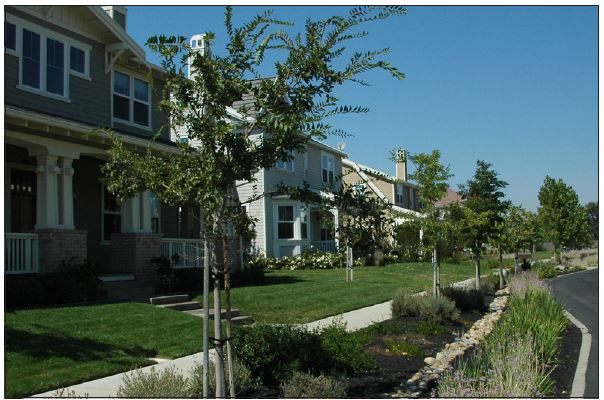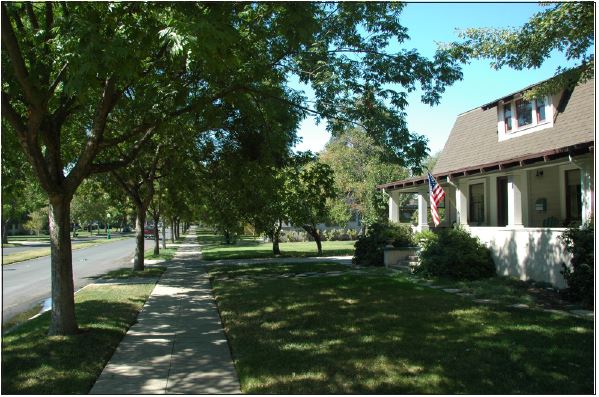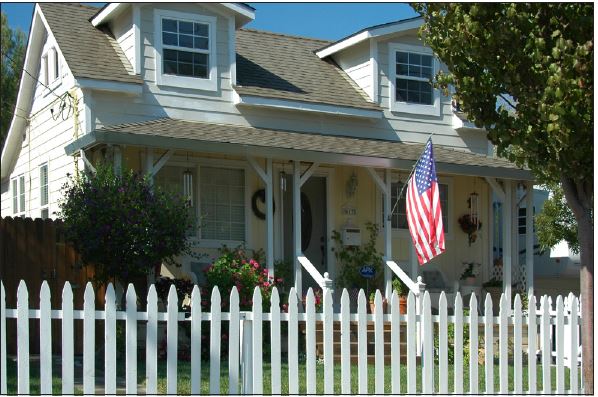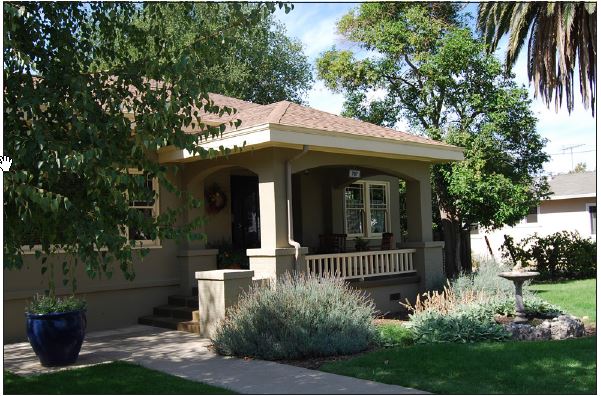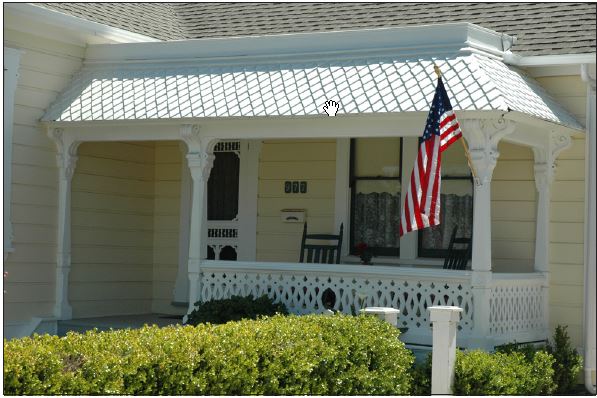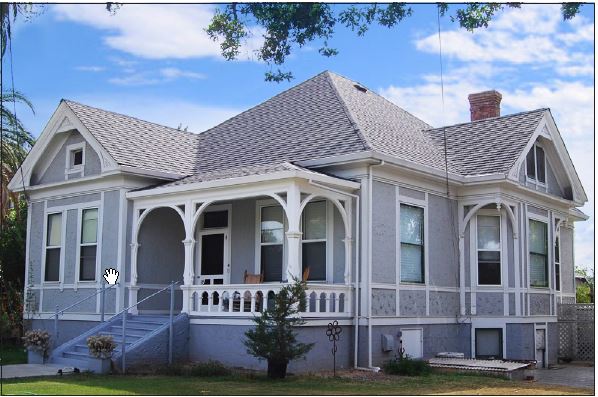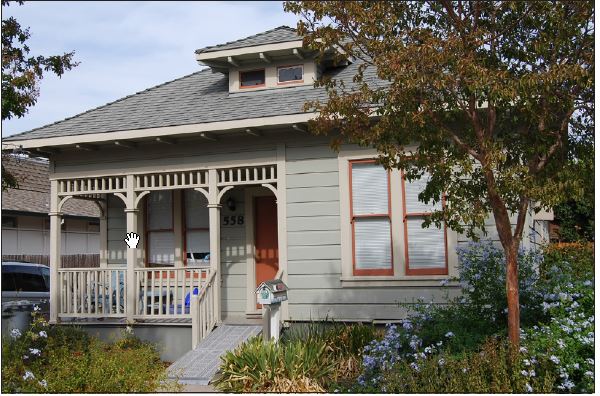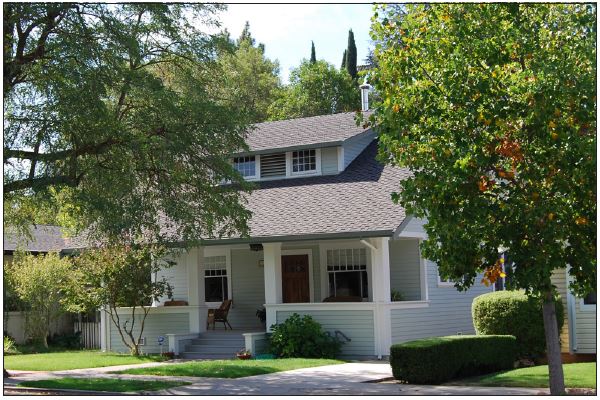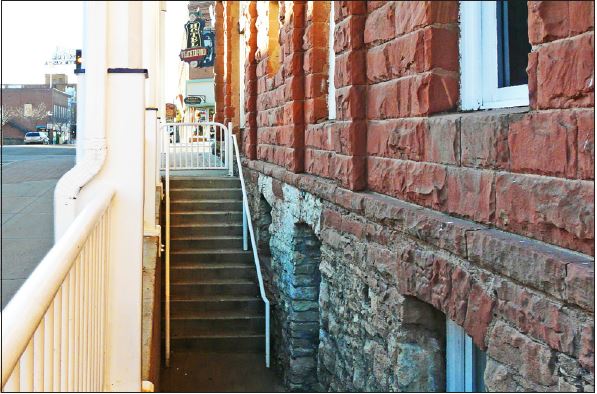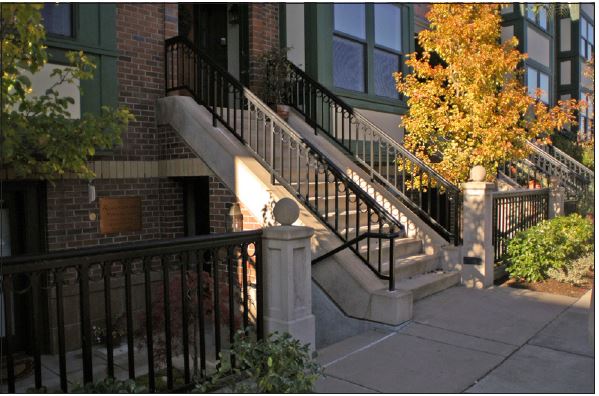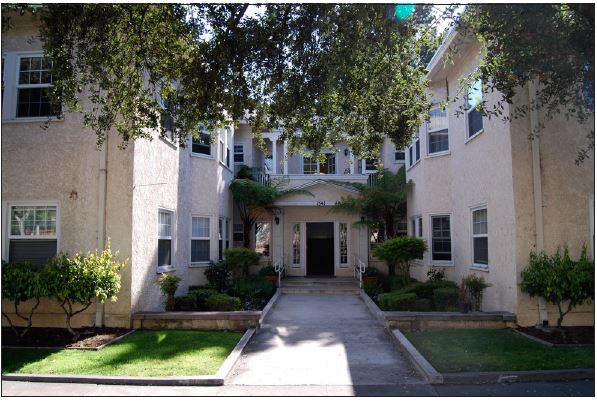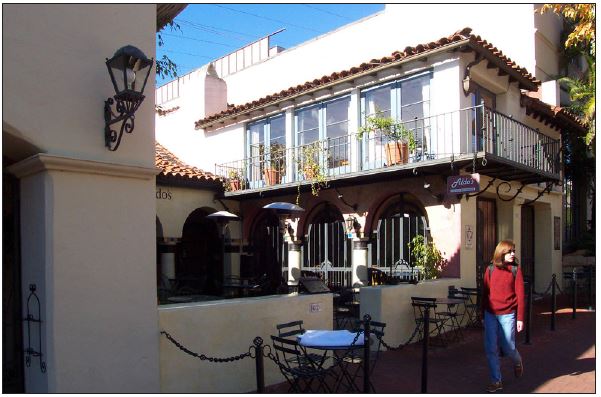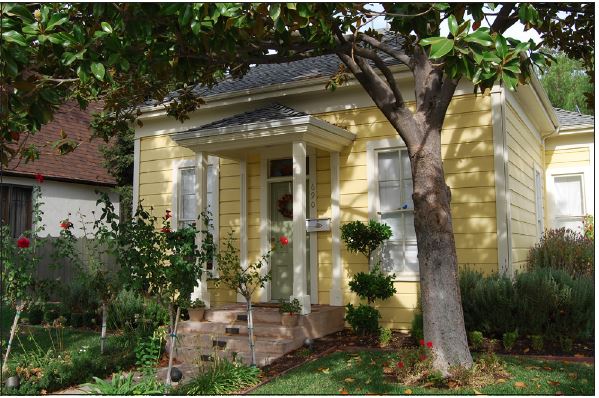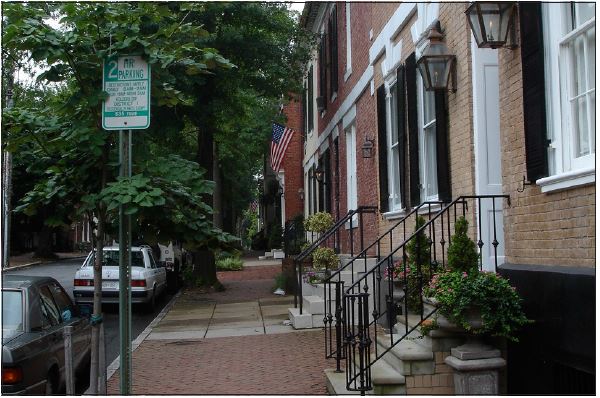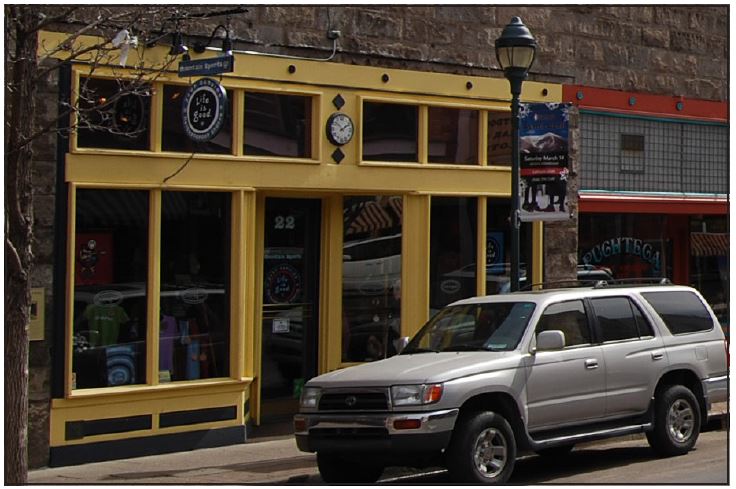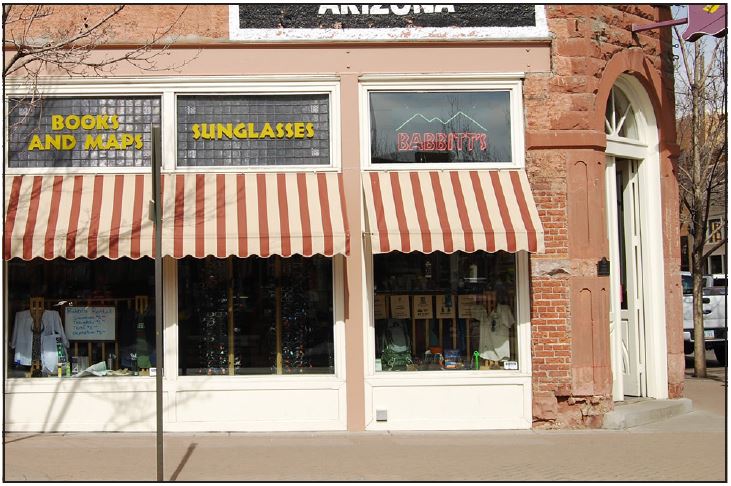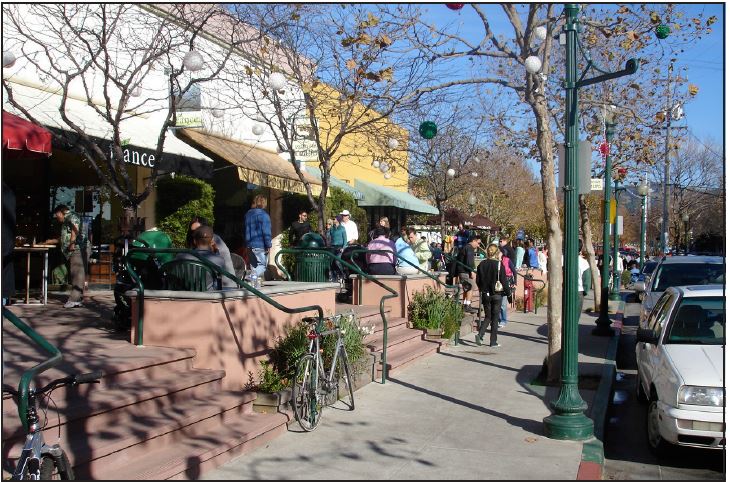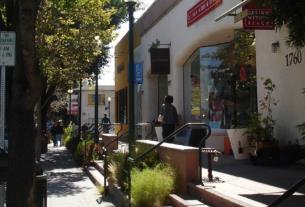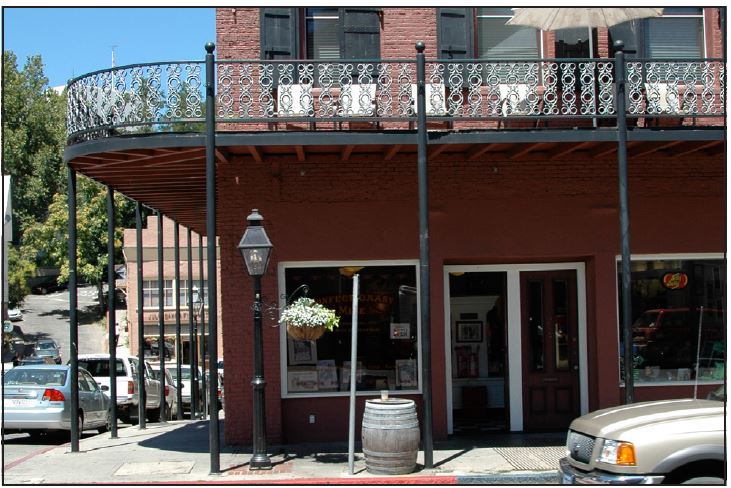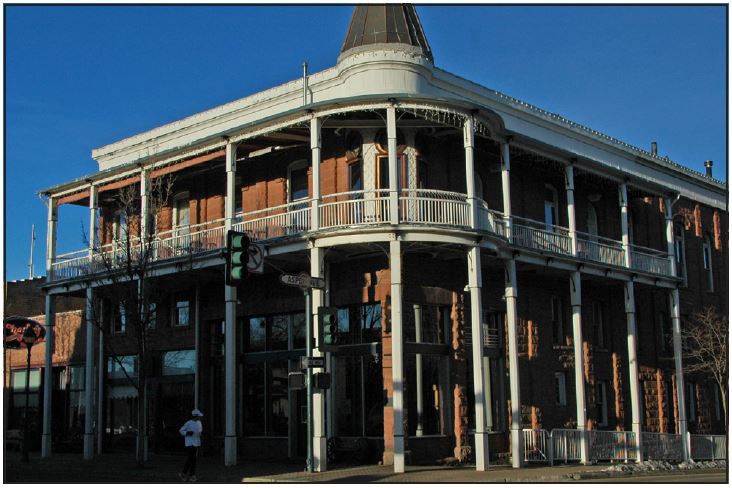Division 10-50.120:
Specific to Private Frontages
Sections:
10-50.120.010 Purpose
10-50.120.020 Applicability
10-50.120.030 Common Yard
10-50.120.040 Porch: Projecting
10-50.120.050 Porch: Engaged
10-50.120.060 Porch: Integral
10-50.120.070 Terrace or Lightwell
10-50.120.080 Forecourt
10-50.120.090 Stoop
10-50.120.100 Shopfront
10-50.120.110 Terrace Shopfront
10-50.120.120 Gallery
10-50.120.010 Purpose
This division provides illustrations, descriptions and standards for private frontage types, and designates the transect zones in which they are allowed. Private frontages are the components of a building that provide a transition and interface between the public realm (street and sidewalk) and the private realm (yard or building). These provisions are intended to ensure development that reinforces and enhances the existing character and scale of Flagstaff’s neighborhoods and downtown, and to promote walkable, sustainable mixed-use environments.
10-50.120.020 Applicability
A. These standards work in combination with the standards found in Division 10-40.40, Transect Zones, and Division 10-50.110, Specific to Building Types, and are applicable to all private frontages within transect zones. If there is a conflict between any standards within the transect zones, the provisions within Division 10-40.40, Transect Zones, control over this division.
B. The standards set forth in this division may also be used in the non-transect zones with Director approval.
|
Frontage Type1 |
Section |
TRANSECT ZONE |
||||||||||
|---|---|---|---|---|---|---|---|---|---|---|---|---|
|
T1 |
T2 |
T3N.1 |
T3N.2 |
T4N.1 |
T4N.1-O |
T4N.2 |
T4N.2-O |
T5 |
T5-O |
T6 |
||
|
Common Yard |
-- |
A |
A |
A |
A |
A |
A |
A |
-- |
-- |
-- |
|
|
Porch, Projecting |
-- |
A |
A |
A |
A |
A |
A |
A |
-- |
A |
-- |
|
|
Porch, Engaged |
-- |
A |
A |
A |
A |
A |
A |
A |
-- |
A |
-- |
|
|
Porch, Integral |
-- |
A |
A |
A |
A |
A |
A |
A |
-- |
A |
-- |
|
|
Terrace or Lightwell |
-- |
-- |
-- |
-- |
-- |
A |
-- |
A |
A |
A |
A |
|
|
Forecourt |
-- |
-- |
-- |
-- |
A |
A |
A |
A |
A |
A |
-- |
|
|
Stoop |
-- |
-- |
A |
A |
A |
A |
A |
A |
-- |
A |
-- |
|
|
Shopfront |
-- |
-- |
-- |
-- |
-- |
A |
-- |
A |
A |
A |
A |
|
|
Terrace Shopfront |
-- |
-- |
-- |
-- |
-- |
A |
-- |
A |
A |
A |
A |
|
|
Gallery |
-- |
-- |
-- |
-- |
-- |
A |
-- |
A |
A |
A |
A |
|
|
End Notes |
|||
|
1 Private frontage type descriptions can be found in subsection A of each frontage type section. |
|
Key |
|||
|---|---|---|---|
|
A |
Allowed |
-- |
Not Allowed |
(Ord. 2017-31, Amended, 12/19/2017; Ord. 2016-07, Amended, 2/16/2016 (Res. 2016-02))
10-50.120.030 Common Yard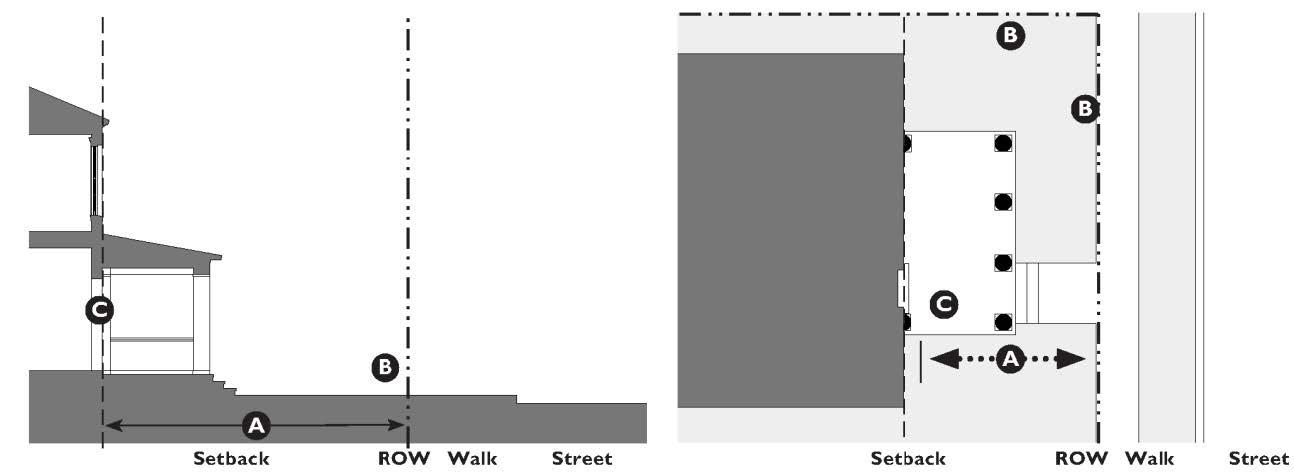
|
Key |
|
|
|
ROW/Property Line |
|
|
Setback Line |
|
|
||||
|
A. Description |
|
The front yards of these houses form a continuous common yard. |
||
|
The main facade of the building typically has a medium to large setback from the property line. The resulting front yard remains unfenced and is visually continuous with adjacent yards, supporting a common landscape and work in conjunction with the other private frontages. |
|
|||
|
B. Size |
|
|||
|
Depth |
20' min. |
|
|
|
|
C. Miscellaneous |
|
|||
|
Fences between front yards or between the sidewalk and front yard are not allowed in common yard frontages. |
|
|
||
|
Common yard frontages shall be used in conjunction with another allowed private frontage. |
|
|
||
|
|
|
|
An example of a common yard. |
|
10-50.120.040 Porch: Projecting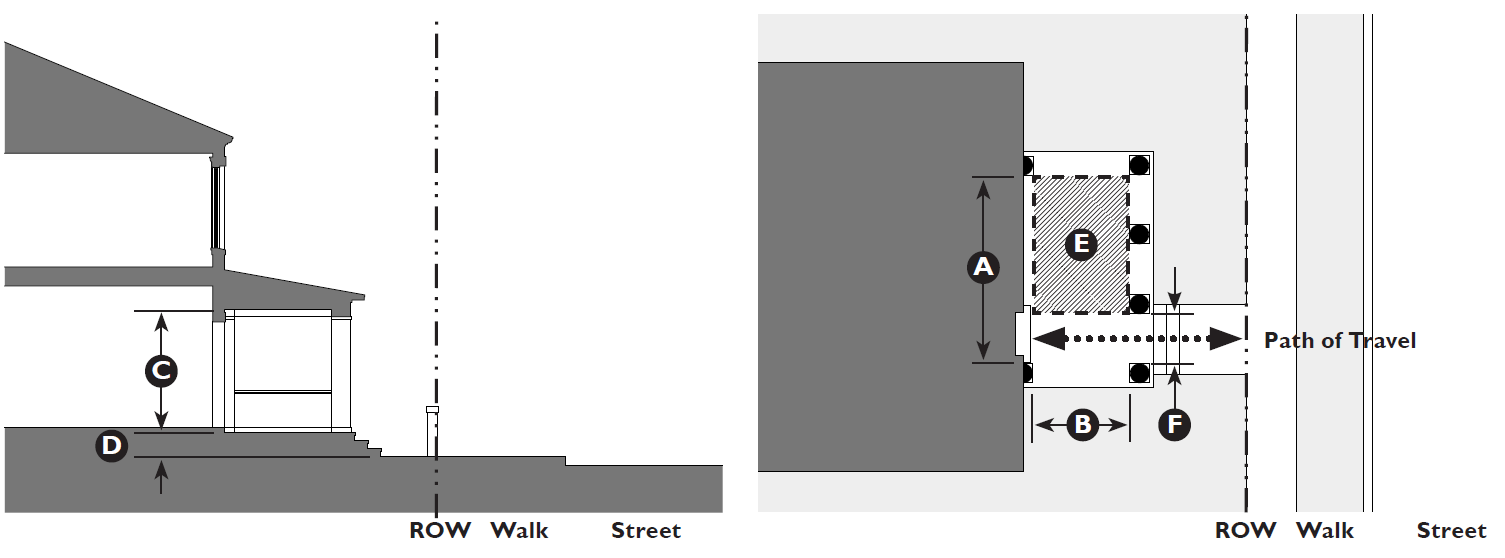
|
Key |
|
|
|
ROW/Property Line |
|
|
||||
|
A. Description |
|
Full-length projecting porch with stairs perpendicular to street. |
||
|
The main facade of the building typically has a small to medium setback from the property line. The resulting front yard is typically very small and may or may not be defined by a fence or hedge to spatially maintain the edge of the street. The projecting porch is open on three sides and has a roof form that is separate from the main house, making it possible to remove the porch roof without making major changes to the overall roof form. |
|
|||
|
B. Size |
|
|||
|
Width, Clear |
10' min. |
|
|
|
|
Depth, Clear |
8' min. |
|
|
|
|
Height, Clear |
8' min. |
|
|
|
|
Height |
2 stories max. |
|
|
Partial-length projecting porch with stairs parallel to street. |
|
Finish Level above Sidewalk1 |
18" min. |
|
|
|
|
Furniture Area, Clear |
4' x 6' min. |
|
|
|
|
Path of Travel |
3' wide min. |
|
|
|
|
End Note |
|
|
||
|
1 Not required in non-transect zones. |
|
|
||
|
C. Miscellaneous |
|
|||
|
Projecting porches are open on three sides and must have a roof. |
|
|
||
|
In transect zones where both porches and encroachments are allowed, a porch is an allowable encroaching element. |
|
|
||
10-50.120.050 Porch: Engaged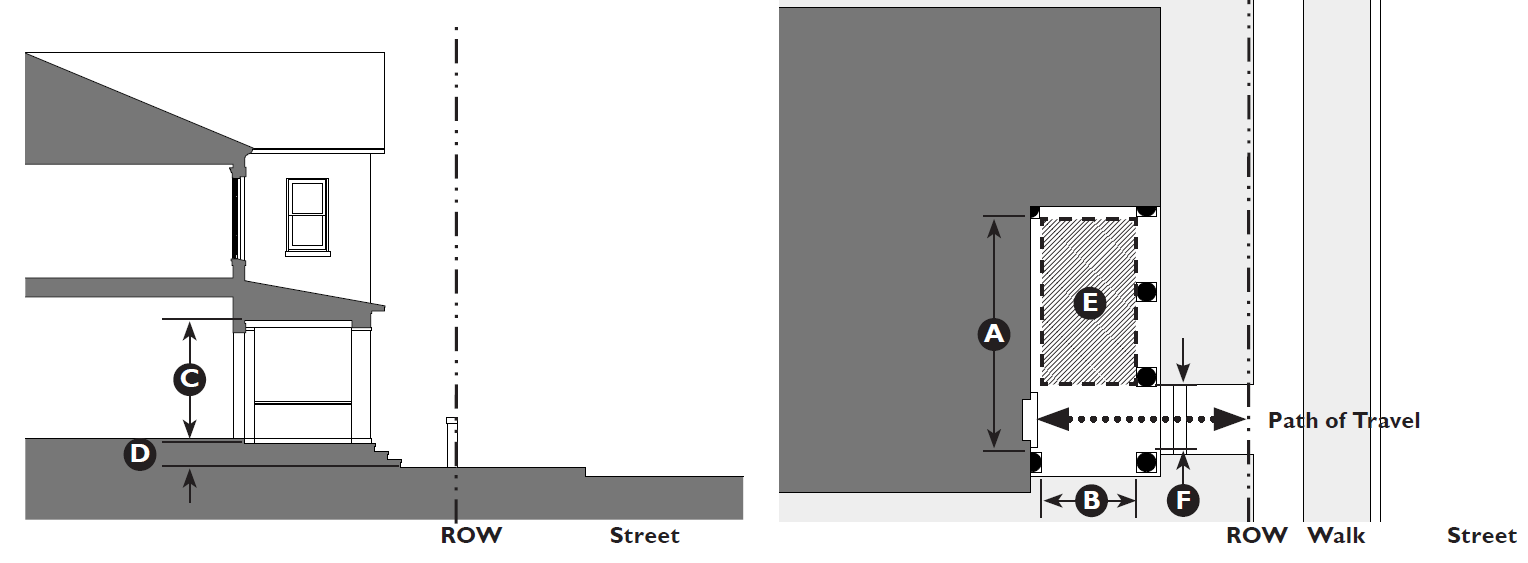
|
Key |
|
|
|
ROW/Property Line |
|
|
||||
|
A. Description |
|
Engaged porch as an attached element. |
||
|
The main facade of the building has a small setback from the property line. The resulting front yard is typically very small and may be undefined or defined by a fence or hedge to spatially maintain the edge of the street. An engaged porch has a separate roof form from the main body of the house, making it possible to remove the porch roof without making major changes to the overall roof form. The porch is partially or fully enclosed on two sides and has a roof. |
|
|||
|
B. Size |
|
|||
|
Width, Clear |
10' min. |
|
|
|
|
Depth, Clear |
8' min. |
|
|
|
|
Height, Clear |
8' min. |
|
|
|
|
Height |
2 stories max. |
|
|
Engaged porch as an attached element. |
|
Finish Level above Sidewalk1 |
18" min. |
|
|
|
|
Furniture Area, Clear |
4' x 6' min. |
|
|
|
|
Path of Travel |
3' wide min. |
|
|
|
|
End Note |
|
|
||
|
1 Not required in non-transect zones. |
|
|
||
|
C. Miscellaneous |
|
|||
|
Engaged porches must be open on at least two sides and have a roof. |
|
|
||
|
In transect zones where both porches and encroachments are allowed, a porch is an allowable encroaching element. |
|
|
||
10-50.120.060 Porch: Integral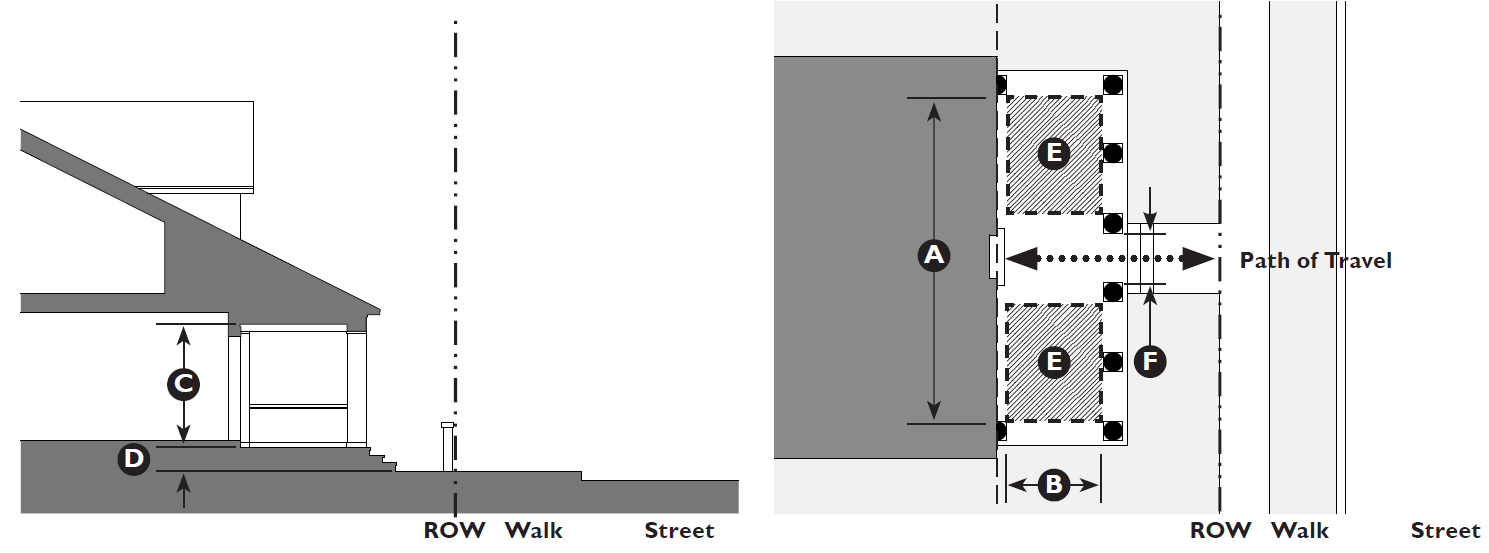
|
Key |
|
|
|
ROW/Property Line |
|
|
||||
|
A. Description |
|
Partial-length integral porch. |
||
|
The main facade of the building has a small setback from the property line. The resulting front yard is typically very small and may be undefined or defined by a fence or hedge to spatially maintain the edge of the street. An integral porch is open on one, two, or three sides and is part of the overall massing and roof form of the building, making it impossible to remove the porch without major changes to the overall roof form. |
|
|||
|
B. Size |
|
|||
|
Width, Clear |
10' min. |
|
|
|
|
Depth, Clear |
8' min. |
|
|
|
|
Height, Clear |
8' min. |
|
|
|
|
Height |
2 stories max. |
|
|
Full-length integral porch integrated into the overall massing. |
|
Finish Level above Sidewalk1 |
18" min. |
|
|
|
|
Furniture Area, Clear |
4' x 6' min. |
|
|
|
|
Path of Travel |
3' wide min. |
|
|
|
|
End Note |
|
|
||
|
1 Not required in non-transect zones. |
|
|
||
|
C. Miscellaneous |
|
|||
|
Integral porches must be open on at least two sides and have a roof. |
|
|
||
|
In transect zones where both porches and encroachments are allowed, a porch is an allowable encroaching element. |
|
|
||
10-50.120.070 Terrace or Lightwell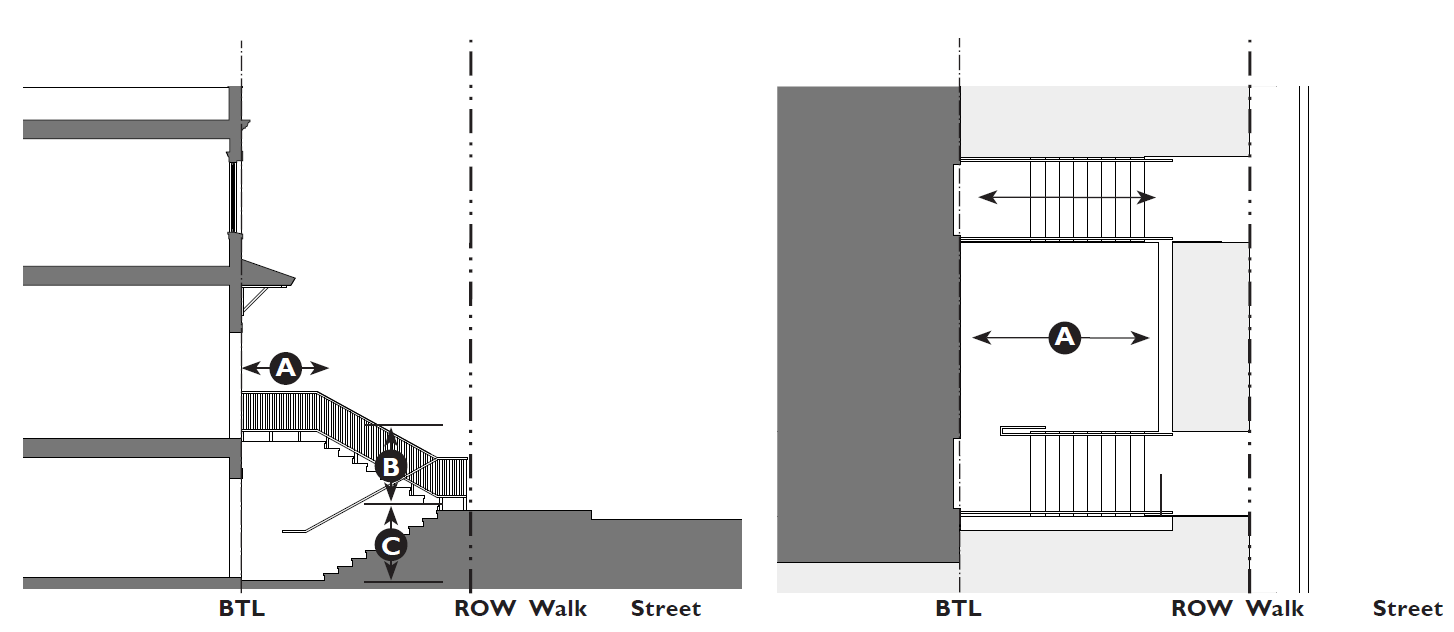
|
Key |
|||
|
|
ROW/Property Line |
|
Setback Line |
Figure 10-50.120.070 Terrace or Lightwell
|
|
||||
|
A. Description |
|
A lightwell in a commercial setting. |
||
|
A frontage where the facade is set back from the frontage line by an elevated terrace or a sunken lightwell. This type buffers residential or commercial uses from urban sidewalks and removes the private yard from public encroachment. Terraces are suitable for conversion to outdoor cafes. |
|
|||
|
B. Size |
|
|||
|
Depth, Clear |
5' min. |
|
|
|
|
Height, Landing |
|
|
|
|
|
Terrace (above Sidewalk) |
6' max. |
|
|
|
|
Lightwell (below Sidewalk) |
6' max. |
|
|
|
|
C. Miscellaneous |
|
A lightwell frontage for a townhouse building. |
||
|
A short wall, hedge, or fence shall be placed along the BTL where it is not defined by a building. |
|
|||
|
|
|
|
|
|
|
|
|
|
|
|
|
|
|
|
|
|
|
|
|
|
|
|
|
|
|
|
|
|
|
|
|
|
|
|
10-50.120.080 Forecourt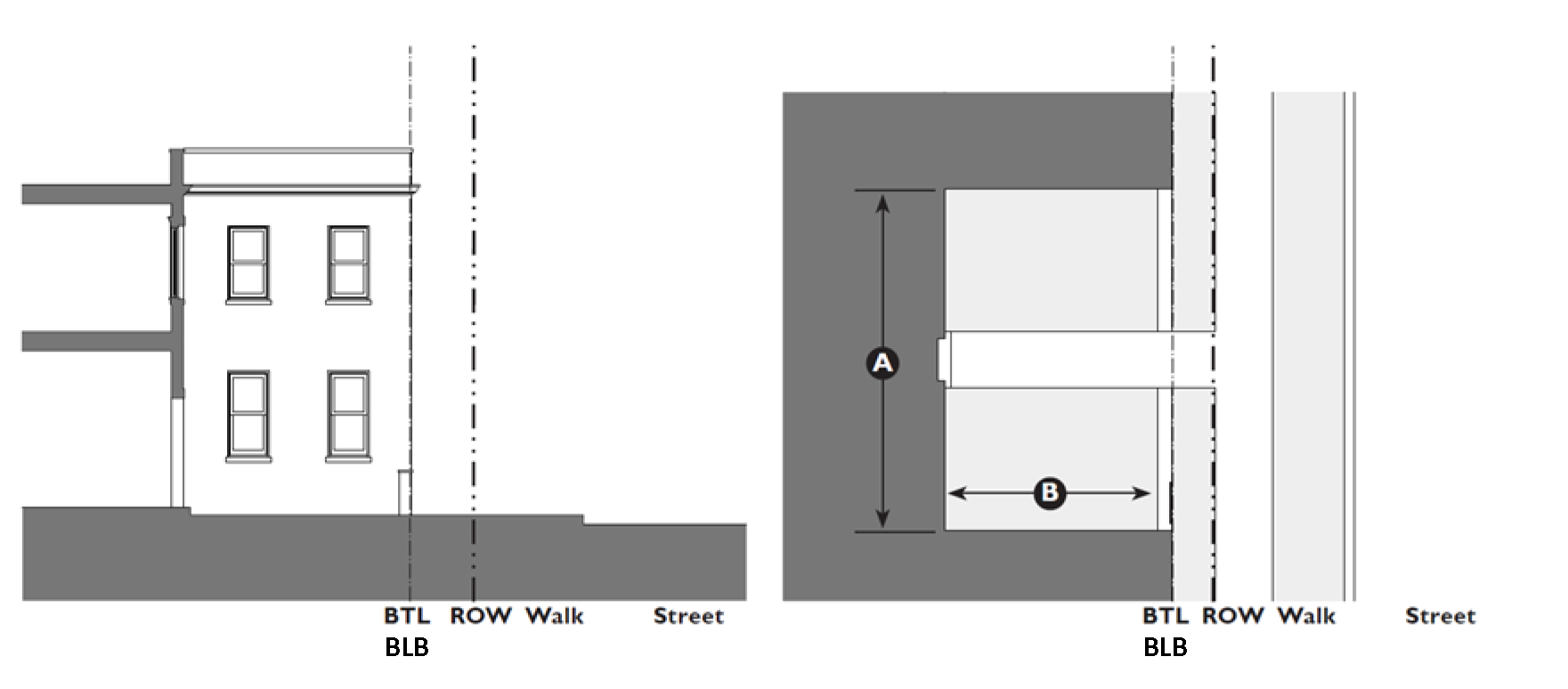
|
Key |
|
|
|
ROW/Property Line |
|
|
BTL – Build to Line (Transect Zones) BLB – Back of Landscape Buffer (Non-Transect Zones), which shall be measured from the property line/right-of-way line in all situations, including Planned Residential Developments. |
Figure 10-50.120.080 Forecourt
|
A. Description |
|
This residential forecourt provides prominent entry yard and breaks down the overall massing along the street. |
||
|
A portion of the main facade of the building is at or near the frontage line and a small percentage is set back, creating a small court space. The space could be used as an entry court or shared garden space for apartment buildings or as an additional shopping or restaurant seating area within commercial areas when it is designed with a hard surface and landscaping as an edge treatment. The proportions and orientation of these spaces should be carefully considered for solar orientation and user comfort. |
||||
|
B. Size |
||||
|
Width, Clear |
12' min. |
|
||
|
Depth, Clear |
12' min. |
|
||
|
C. Miscellaneous |
|
This commercial forecourt provides an outdoor dining area along a vibrant commercial street. The ROW is defined by a low wall as required by this Zoning Code. |
||
|
In commercial areas this frontage type should be used sparingly and should not be repeated along a block frontage. |
|
|||
|
A short wall or fence shall be placed along the BTL where it is not defined by a building. |
|
|||
|
|
|
|||
|
|
||||
|
|
||||
|
|
||||
(Ord. 2020-11, Amended, 5/5/2020 (Res. 2020-17); Ord. 2016-07, Amended, 2/16/2016 (Res. 2016-02))
10-50.120.090 Stoop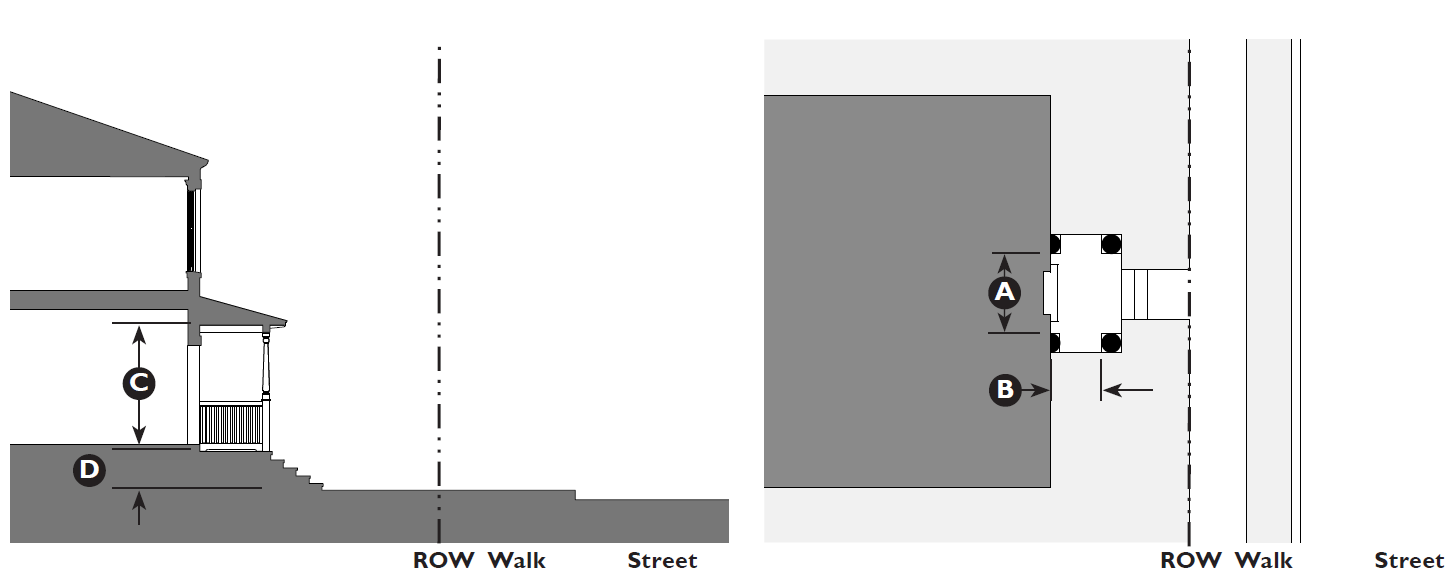
|
Key |
|
|
|
ROW/Property Line |
Figure 10-50.120.090 Stoop
|
|
||||
|
A. Description |
|
This stoop on single-family dwelling with a medium setback engages the street. |
||
|
The main facade of the building is near the frontage line and the elevated stoop engages the sidewalk. The stoop should be elevated above the sidewalk to ensure privacy within the building. Stairs from the stoop may lead directly to the sidewalk or may be side-loaded. |
|
|||
|
B. Size |
|
|||
|
Width, Clear |
5' min.; 8' max. |
|
|
|
|
Depth, Clear |
5' min.; 8' max. |
|
|
|
|
Height, Clear |
8' min. |
|
|
|
|
Height |
1 story max. |
|
|
|
|
Finish Level above Sidewalk1 |
18" min. |
|
|
|
|
End Note |
|
|||
|
1 Not required in non-transect zones. |
|
These stoops on townhouses with slightly recessed entries and a minimum setback allows the steps to engage the street. |
||
|
C. Miscellaneous |
|
|||
|
Depth of recessed entries |
4' max. |
|
||
|
Stairs may be perpendicular or parallel to the building facade. |
|
|||
|
Ramps shall be parallel to facade. |
|
|
||
|
The entry door shall be covered or recessed to provide shelter from the elements. |
|
|||
|
Gates are not permitted. |
|
|||
|
All doors must face the street. |
|
|||
|
|
|
|
|
|
|
|
|
|
|
|
10-50.120.100 Shopfront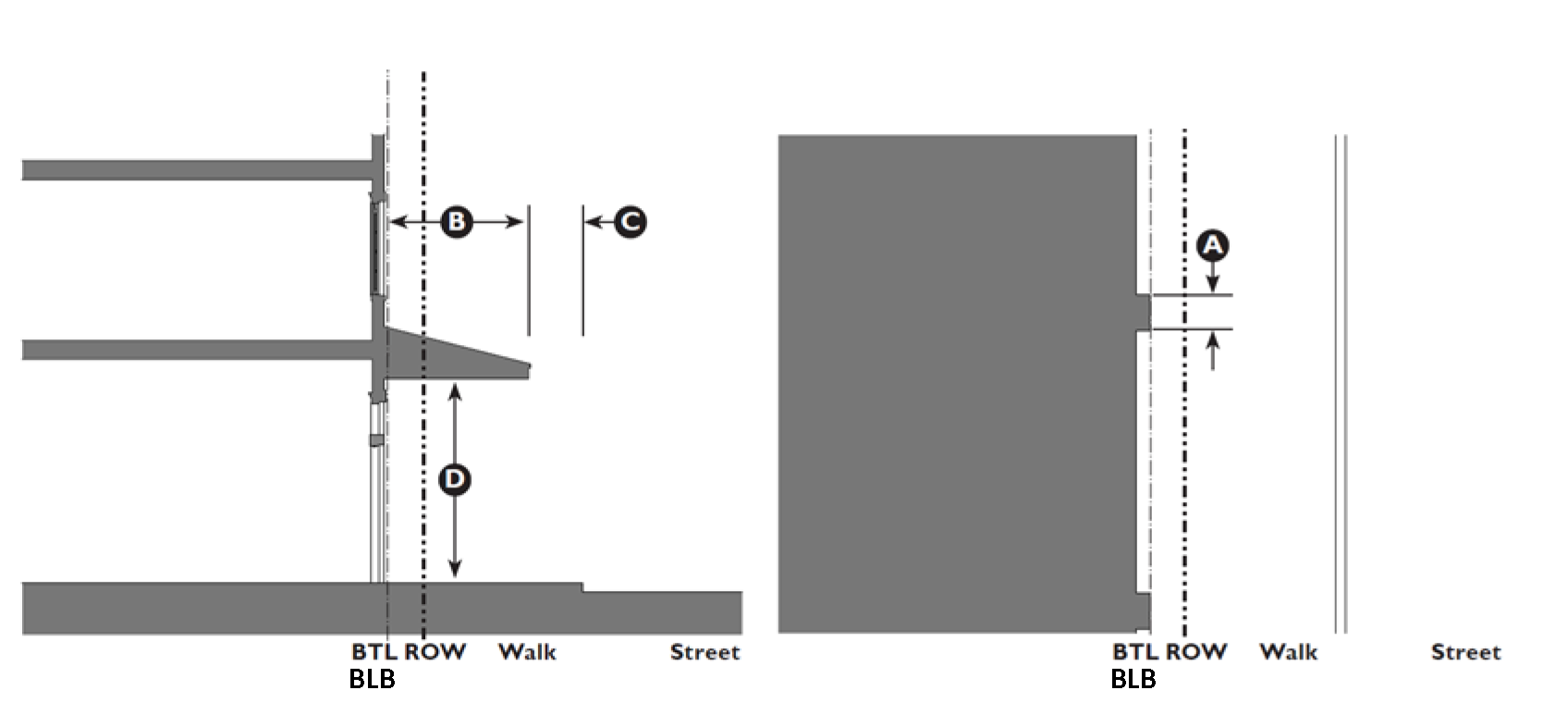
|
Key |
|
|
|
ROW/Property Line |
|
|
BTL – Build to Line (Transect Zones) BLB – Back of Landscape Buffer (Non-Transect Zones), which shall be measured from the right-of-way line in all situations, including Planned Residential Developments. |
Figure 10-50.120.100 Shopfront
|
A. Description |
|
An example of a shopfront with a recessed doorway. |
||
|
The main facade of the building is at or near the frontage line and may include a canopy or awning element overlaps the sidewalk along the majority of the frontage. The canopy is a structural cantilevered shed roof and the awning is canvas or similar material and is often retractable. |
|
|||
|
B. Size |
|
|||
|
Distance between Glazing |
2' max. |
|
|
|
|
Ground Floor Transparency |
75% min. |
|
|
|
|
Door Recess |
5' max. |
|
|
|
|
C. Awning |
|
An example of a shopfront with a chamfered corner entry. |
||
|
Depth |
4' min. |
|
|
|
|
Setback from Curb |
2' min. |
|
|
|
|
Height, Clear |
8' min. |
|
|
|
|
D. Miscellaneous |
|
|||
|
Residential windows shall not be used. |
|
|||
|
Doors may be recessed as long as main facade is at BTL. |
|
|||
|
Open ended awnings encouraged. |
|
|||
|
Rounded and hooped awnings are discouraged. |
|
|||
|
Shopfronts with accordion-style doors/windows or other operable windows that allow the space to open to the street are encouraged. |
|
|||
|
Transom bars shall be used to break down the window scale. |
|
|||
(Ord. 2020-11, Amended, 5/5/2020 (Res. 2020-17))
10-50.120.110 Terrace Shopfront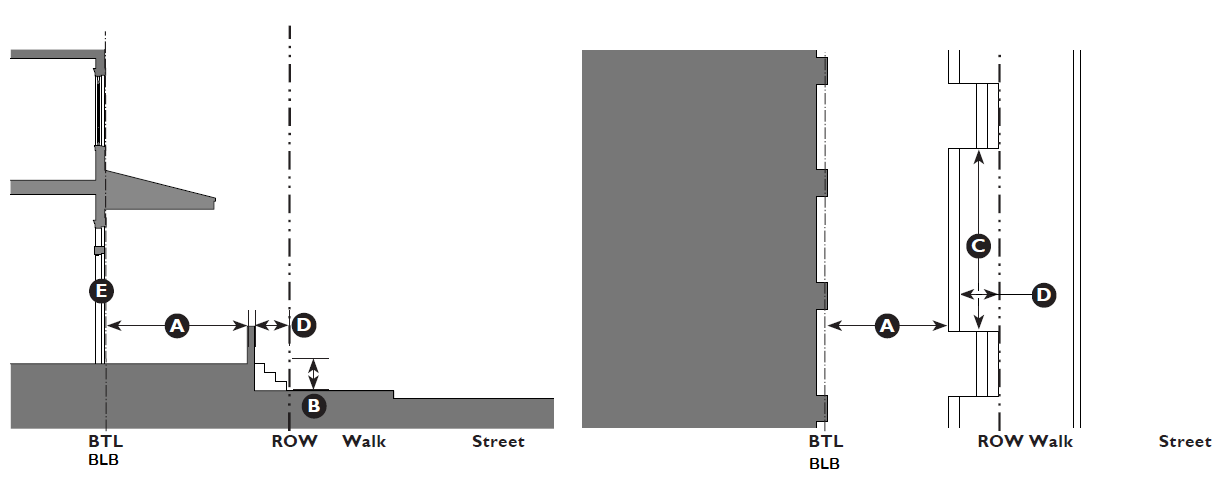
|
Key |
|
|
|
ROW/Property Line |
|
|
BTL – Build to Line (Transect Zones), unless a greater setback is required by the sum of the distance of A and D. BLB – Back of Landscape Buffer (Non-Transect Zones), which shall be measured from the right-of-way line in all situations, including Planned Residential Developments, unless a greater setback is required by the sum of the distance of A and D. |
Figure 10-50.120.110 Terrace Shopfront
|
|
||||
|
A. Description |
|
Frequent stairs open the terrace to the sidewalk. |
||
|
This frontage type is only to be used when a shopfront frontage is required or desired and a cross slope exists on the site that makes access into the shop difficult across the front of the commercial use. The terrace allows at-grade access to all shopfronts. The terrace is accessed at grade and as the sidewalk follows the slope, the terrace follows the plane of the shopfront finished floor level. Frequent steps from the sidewalk to the terrace are necessary to avoid a dead wall along the sidewalk and to maximize access to the spaces. |
|
|||
|
|
||||
|
|
||||
|
|
|
|
|
|
|
|
|
|
|
|
|
B. Size |
|
The terrace allows at-grade access to shopfronts along a cross slope. |
||
|
Depth, Clear |
8' min. |
|
|
|
|
Finish Level above Sidewalk |
3'6" max. |
|
|
|
|
Length of Terrace |
120' max. |
|
|
|
|
Distance between Stairs |
25' max. |
|
|
|
|
Wall Setback from ROW |
12' min. |
|
|
|
|
C. Miscellaneous |
|
|||
|
Terrace shopfronts must also follow all of the regulations for the shopfront frontage type. |
|
|
||
|
Low walls shall be made into or be able to be used as seating to the maximum extent feasible. |
|
|
||
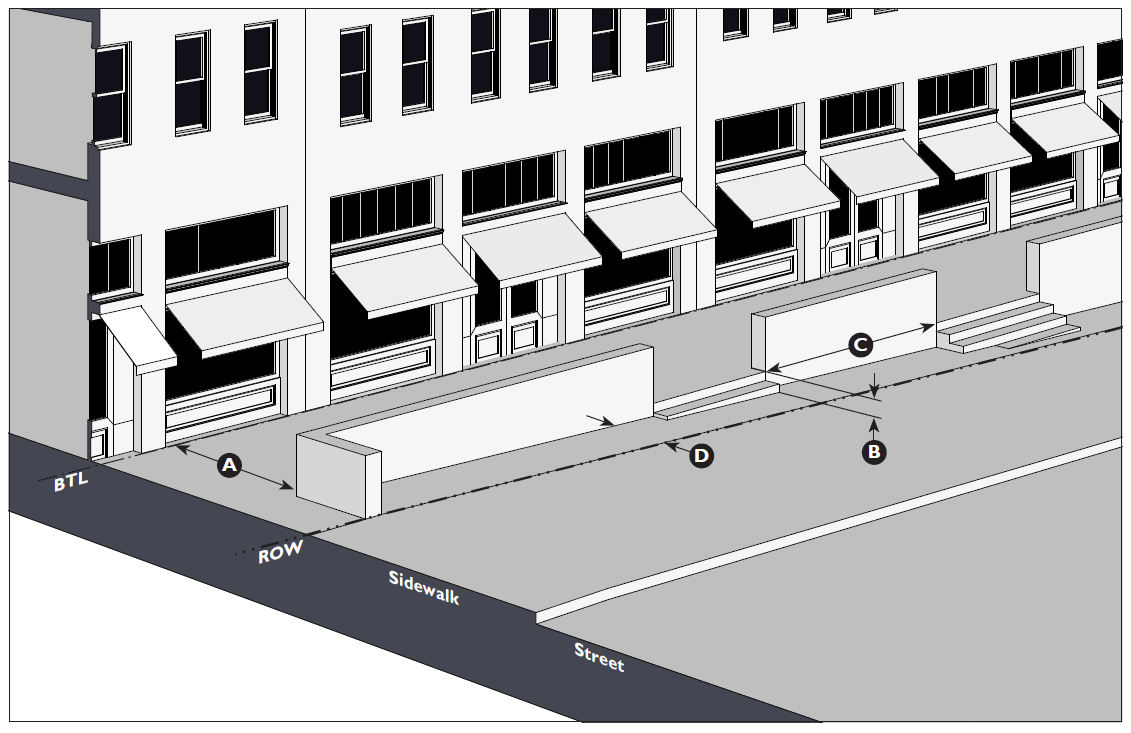
(Ord. 2020-11, Amended, 5/5/2020 (Res. 2020-17))
10-50.120.120 Gallery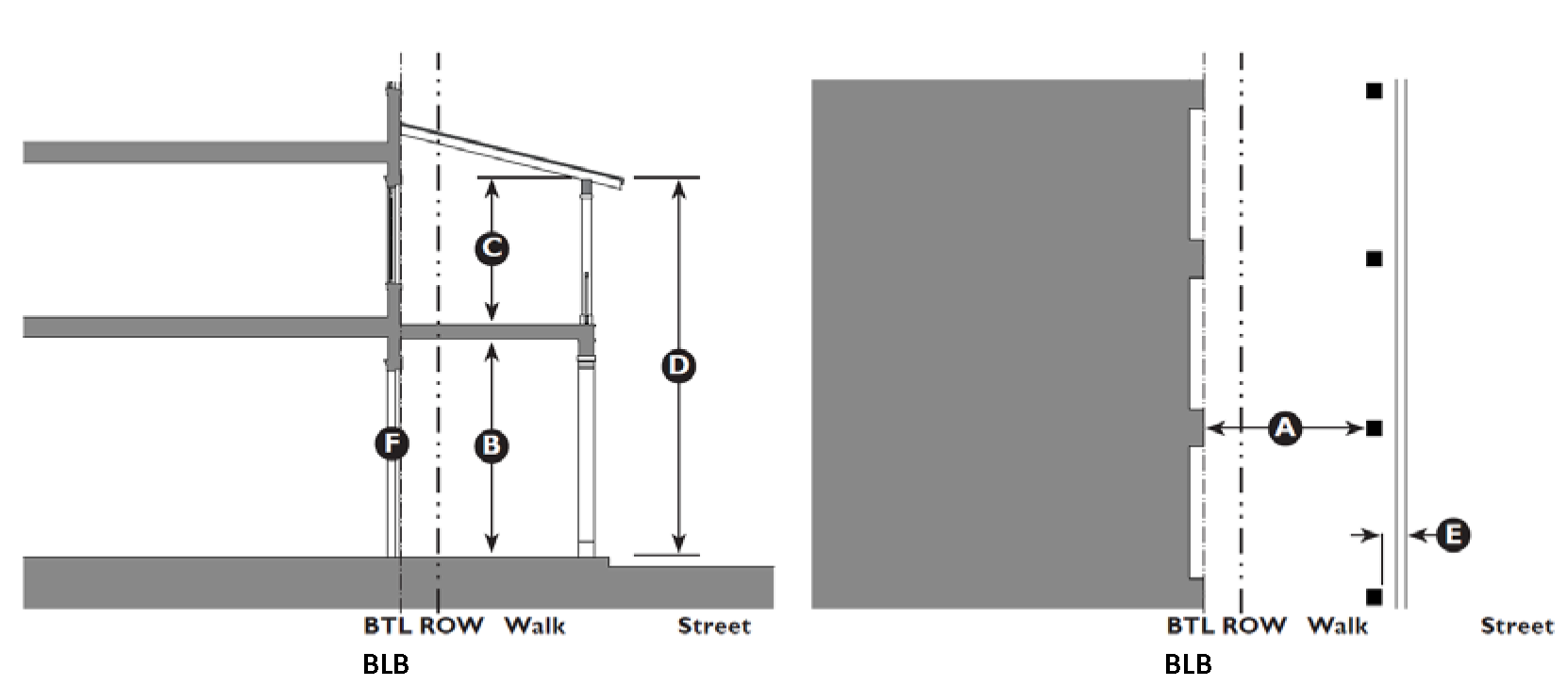
|
Key |
|
|
|
ROW/Property Line |
|
|
BTL – Build to Line (Transect Zones) BLB – Back of Landscape Buffer (Non-Transect Zones), which shall be measured from the right-of-way line in all situations, including Planned Residential Developments. |
Figure 10-50.120.120 Gallery
|
|
||||
|
A. Description |
|
A two-story gallery where the second floor is uncovered. |
||
|
The main facade of the building is at the frontage line and the gallery element overlaps the sidewalk of the right-of-way. This frontage type is intended for buildings with ground-floor commercial or retail uses and may be one or two stories. Due to the overlap of the right-of-way, an easement is usually required. Alternatively the lot line shall be aligned with the edge of the gallery and curb, and a sidewalk is established within an easement under the gallery. |
|
|||
|
B. Size |
|
|||
|
Depth, Clear |
8' min. |
|
|
|
|
Ground Floor Height, Clear |
11' min. |
|
|
|
|
Upper Floor Height, Clear |
9' min. |
|
|
|
|
Height |
2 stories max. |
|
|
|
|
Setback from Curb |
2' min.; 3' max. |
|
|
|
|
C. Miscellaneous |
|
A two-story gallery frontage. |
||
|
Galleries must also follow all of the regulations for the shopfront frontage type. |
|
|
||
|
Upper-story galleries facing the street must not be used to meet primary circulation requirements. |
|
|||
|
Galleries must have a consistent depth along a frontage. |
|
|||
|
Gallery must project over a sidewalk. |
|
|||
|
|
||||
(Ord. 2020-11, Amended, 5/5/2020 (Res. 2020-17))



